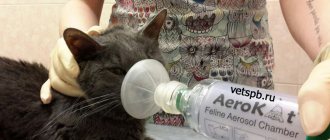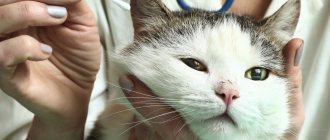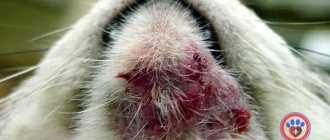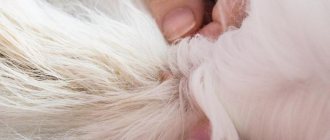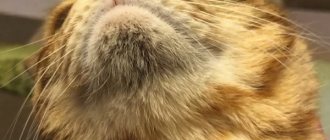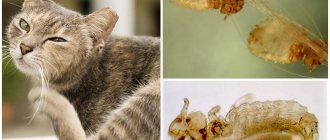Main causes of spotting
Black spots in a cat's mouth occur due to the influence of various factors that determine the type of disease.
Acne looks like dark rashes or small pinkish pimples. They are located outside - around the mouth area, on the lower lip. The favorite place to appear is the chin, as the sebaceous glands actively work there. Causes:
- Incorrect feeding. For example, giving food from the table. This leads to an imbalance of nutrients, a lack of vitamins, microelements and other useful elements.
- Pet uncleanliness. Often cats do not remove the remaining food from their faces, which provokes inflammation of the skin.
- The influence of stress factors.
- Response to irritation by an allergen. It appears as a rash in areas of interaction with the irritant.
- Negligent attitude of the owners towards the cleanliness of the bowls.
- Genetic disease.
The first 5 reasons can be eliminated, then the animal will return to normal. With the hereditary transmission of dark rashes, you will have to come to terms with the fact that they will not go away. They will also not cause harm to the cat's health.
Symptoms: dark acne; inflammatory reaction on the mucous membrane of the lower lip; suppuration and swelling of rashes; the appearance of crusts in the oral cavity. Acne occurs from time to time, but more often it is chronic.
Lentigo
The most likely cause of dark spots in a cat's mouth. In this case, the stains are harmless. They are characteristic not only of animals, but also of humans. Lentigo appears in adult animals in the form of small pigmented areas. Whereas in kittens, the oral cavity is the same shade, clean. With age, the size and number of spots increase. Localization of skin defects - gums, palate, nose, lips, chin. Type of spots: on the same level with the mucous membrane or skin, smooth surface, no itching, peeling, pain, or discomfort. Red and spotted cats are susceptible to lentigo. You can compare them to freckles in humans.
Fungus
Fungal diseases are rare. The cause is the development of fungi with a decrease in the body's defenses. This explains the manifestation of symptoms in kittens, weakened after operations, and elderly animals. There are no specific signs. The fungus is characterized by the appearance of crusts and dark spots.
How to warn?
Cats are quite clean animals, so rashes on the lips, apart from hereditary ones, are quite rare. A poorly balanced diet and the inability of a cat to replenish its diet with the vitamins and minerals it needs leads to an imbalance of the entire body. The owner needs to monitor the animal’s food and wash the food bowl on time, since bacteria multiply well in dirty dishes, which can get into the mouth while eating. Air pollution and frequent psychological stress from aggressive behavior with the pet by its owner can also cause the appearance of spots and spots. Only the care and quick reaction of the owner to any changes in the behavior or appearance of the pet will give it a long and happy life.
Tumors in a cat's mouth.
Tumors in the mouth and throat are less common in cats than in dogs. Unfortunately, tumors that do arise are often malignant.
Gingival fibroma is a benign (non-growing) growth that usually occurs near the gum line. The growth is relatively insensitive and hard, having either the color of normal gums or a slightly paler color. The amount can be large enough to completely cover the surface of several teeth. The usual treatment is surgical removal of the fibroid. After the operation, daily rinsing is prescribed until the cat recovers completely.
Epulis (supragingival, Epulides) is another type of benign tumor-like formation that occurs on the gums. In practice this is rare. This type of tumor usually affects only the area around one tooth. A biopsy of tissue samples may be performed for proper diagnosis and treatment.
Squamous cell carcinoma is the most common malignant tumor in the oral cavity of cats. Usually occurs on the gums and tongue, then quickly spreads throughout the mouth.
Symptoms depend on the location and size of the tumor. Typically, bad breath, refusal to eat, and excessive drooling are observed. If the swelling affects the back of the mouth or throat, swallowing may be difficult. The tumor often has ulcers and bleeds. Your cat's face may become swollen as the tumor enlarges and invades surrounding tissue.
Treatment and prognosis depend on the type of tumor and its stage. Malignant melanomas are highly invasive and grow rapidly, so the prognosis is poor. Surgical removal improves the chances of survival and may even eliminate the tumor, but recurrences are common. Squamous cell carcinoma has a poor prognosis and survival is only possible with early diagnosis and treatment. Removing a tumor often requires removal of the lower jaw.
Causes of a black tongue in a cat
Very often, a cat develops a dark coating on his tongue or black dots appear when eating dark-colored food. Often, black dots can remain on a cat's tongue if he has chewed painted wood or plastic. Particles of dye get clogged between the papillae on the tongue and the impression of dark dots and spots is created.
Spots on a cat's tongue may remain if he chews something.
A black tongue and black spots on it can also occur with increased pigmentation, diseases of the oral cavity, various infections, and a lack of vitamins in the diet. In order to distinguish plaque from disease or pigmentation, you need to rub the cat's tongue with a toothbrush. If the dark spots come off easily, we can talk about plaque. Pigment spots on a cat's tongue cannot be removed.
In Siamese and black cats, blackening of the tongue, gums and lips may be part of the coloration that develops as the kitten matures.
Causes for concern are the formation of dark plaque on the cat’s lips and nose, as well as the presence of an unpleasant, putrid odor from the mouth. In this case, you need to show the animal to a veterinarian.
Diagnosis and treatment
Although pigmentation in most cases is not dangerous, you should take your pet to the veterinarian. He will establish the exact cause using a visual examination, laboratory tests, and examination of the mucous membrane for bacterial contamination. Treatment:
- With acne, it is enough to get rid of the cause that caused the rash. The animal's condition will return to normal.
- Lentigo is a congenital manifestation, so no treatment is required.
- For fungal diseases, antiseptics are prescribed for rinsing (Stomadex, solutions of Chlorhexidine, hydrogen peroxide, furatsilin) and antifungal agents (potassium iodide, Clotrimazole, Amphotericin).
- Mycoplasmosis - therapy consists of restoring the immune system, giving antibiotics (Ofloxacin, Azithromycin), treating the oral cavity (Ribotan, Cycloferon). Probiotics and Feliferon injections can be prescribed.
- Oncological diseases often remain untreated.
For any reason, it is mandatory to include vitamin-mineral complexes in the diet.
Black dots near the mouth and on the nose: what could it be?
Sudden spots on the chin and nose make you think that the cat dipped its face in motor oil or buried it in black mud. If the version is confirmed, you can breathe easy; if not, then you need to dig further.
Suspicious specks can be a signal to buy a flea comb, which can be used to check for the presence of parasites. A strip of fur along the spine to the tail is the favorite place of these microscopic creatures, but sometimes they stick to the stomach, neck and head of the cat. If similar points are found under the fur, it is necessary to use special preparations. If the skin is clear elsewhere, your pet most likely has acne.
General prevention
Attention to the cat’s oral cavity is the main rule for preventing inflammation.
Since the main causes of both diseases are common, preventive measures will be common for both diseases.
The first and inviolable rule of prevention is special attention to pets.
It is necessary to carefully monitor the condition of the cat's oral cavity.
, clean regularly, approximately once or twice a week. The cat's diet must be balanced with the necessary vitamin and mineral supplements. Do not feed only soft food.
It is recommended that your pet consume ready-made food designed specifically for cleaning teeth and preventing the formation of tartar. If this has already happened, do not delay visiting a doctor. Otherwise, the complication is fraught with the loss of the entire jaw, which for a predator is tantamount to death.
Cats always give the impression of being extremely clean animals, as they lick their entire body for a long time to maintain hygiene. They do this not so much to remove dirt as to neutralize a specific odor. Since the cat’s tongue is always visible, it is not surprising that with its pathologies, the owner quickly notices signs that something is wrong. In particular, you should be wary if you notice a white tongue on a cat.
Your kitty's tongue is a multi-functional tool.
It is used for food and drink, performing the function of a kind of “spoon”; with its help, the animal keeps its fur and skin in order. Thus, with any more or less serious diseases of this organ, the animal will have serious problems. It will not be able to take care of itself, and the process of eating food will become noticeably more difficult. So what diseases, in principle, can directly contribute to a change in the color of the tongue?
Any inflammatory pathology of the oral cavity can lead to such consequences. The simplest and most common option is stomatitis.
, also known as inflammation of the tissues of the oral cavity. is common and quite likely
(this term refers to inflammation of the tongue itself).
It is possible that the whitish coating on the surface of the organ appeared as a result
(that is, of the same inflammation, but of the gums).
White tongue
– a rather characteristic, specific symptom indicating the initial stages of tartar formation
. If at this moment you start treating your teeth and tongue with a weak water-salt solution, or a solution of baking soda, serious consequences can be avoided. In addition, a white tongue (more precisely, the root of the tongue) is a fairly common sign of acute (inflammation of the gastric mucosa). With chronic inflammation, the tongue also turns white, but more often this can be noticed only during the period of exacerbation of the disease.
Oncological diseases
If you look into a cat’s mouth, you can see black dots on the gums that weren’t there before, and the animal is already many years old, you can sound the alarm. Such spots may be a manifestation of melanoma, a dangerous cancer associated with pigmentation.
The tumor is sometimes located on the oral mucosa or metastasizes here, being located in another part of the body. The second option is sadder than the first, because it speaks of an advanced stage of the disease and the futility of treatment.
Melanoma in cats does not only appear as dark spots. The animal loses its appetite, looks exhausted, and apathetic. As soon as the first alarming signs appear, the pet needs to be shown to a veterinarian. In the case of oncological tumors, it is extremely important to start treatment in a timely manner.
However, cancer is not common in furries. In most cases, spots on a cat's lips or mouth turn out to be normal pigmentation.
. The doctor will examine the animal and, if necessary, prescribe a diagnosis and explain why the color of the mucous membrane has changed. After this you will be able to sleep peacefully.
A change in the color of the mucous membrane of a cat's lips is an alarming symptom indicating an infection, an allergic reaction, or a malfunction of internal organs. If a cat has a black spot or several spots in the corners of its mouth that do not cause discomfort, acne is a possible cause. It is possible to accurately identify the cause of such spots only after laboratory tests and bacteriological examination of the composition of the mucous membrane.
One of the most likely causes of blackness at the corners of a cat's lips is acne. It appears as a dense dark rash or small pinkish inflamed nodules on the lower lip and chin. Specific symptoms:
- dark spots of comedones;
- inflammation of the mucous membrane of the lower lip (rarely observed);
- swelling and inflammation of the rash on the chin;
- formation of crusts around the mouth.
Acne appears sporadically, but can also be a chronic disease. The disease most often develops due to metabolic disorders, decreased immunity or insufficient hygiene of the pet.
In rare cases, inflammation of the hair follicles may be the result of an allergic reaction to food or the material of the dishes from which the cat eats. In this case, black dots and a pink dense rash appear in places that come into contact with the irritant. If the allergy is triggered by new dishes, a rash will appear on the lower lip and chin.
Blackness and character
It is widely believed that black spots in a cat’s mouth are a sign of an aggressive, evil character. Especially when located on the palate or the inside of the lips. However, it has been proven that pigmentation does not affect the pet’s behavior in any way. With spots, he can be kind, affectionate, and flexible.
In 99% of cases, dark spots are not dangerous. They are normal pigmentation. If this is a concern, consult your veterinarian. Malignant tumors are rare, but are more often found in a severe stage and cannot be treated.
Emergency help
Black dots and spots on the tongue, gums and face, even if they are just acne or moles, are a sufficient reason to visit a veterinary clinic. Any change in the skin creates an area for the penetration of fungal and bacterial infections. Only a veterinarian can rule out serious diagnoses with similar symptoms.
Timely treatment helps to avoid complications and support the cat’s immune system in the fight against infectious diseases. Even such a terrible diagnosis as oncology is not a death sentence. If detected in the early stages, it is possible to surgically remove the formation and consolidate the result with therapy.
More serious problems
Thus, a cat's tongue can be a real "barometer" of health. A change in color is an indicator that your cat may be sick. You can remember a simple truth: “A pink tongue is a healthy pet.” This rule is immutable; exceptions are very rare.
Why is that? The fact is that the tongue, as a muscular organ, is literally penetrated by many blood vessels, visible through the thin epithelial layer. If it is pink, everything is in order - the blood supply is normal, the red blood cells contain the required amount of hemoglobin. In many cases, a white tongue is a sign of poor oral hygiene, but below we will describe much more serious pathologies in which this organ also changes its color.
Causes of rashes depending on location
According to experts, one of the most common causes of blackheads in cats is pollution. But at the same time, this condition can be a consequence of other reasons.
Black spots on the lower jaw
Dark-colored sores can appear on the lower jaw in cats due to hereditary predisposition. In this case, you can ensure the normal condition of the skin with the help of properly selected hygiene products.
Black dots on a cat's lower jaw
On the lips
Having noticed black spots on a cat's lips, every owner should be wary. This manifestation may indicate the development of fungal diseases. At the first signs, it is important to immediately seek qualified help, since it is impossible to independently determine the type of infection.
Spots on the lips of ginger cats
Approximately 60-70% of Russians live at home with a purr. We perceive pets as family members and take care of them no less than we would a child. In addition, the Red Cat is a real healer! Read: Features of red-colored cats.
Naturally, when we see brown spots on our beloved furry that were not there before, we involuntarily tense up and ask ourselves the question - what if this is something dangerous? We involuntarily go on the Internet, see scary pictures, nervously read sites with terrible diagnoses and look at our pet. But before you panic, you should figure out what it really is.
Comments
Hi, does anyone know what small black spots in a cat's mouth could mean? She is 4 years old, has not given birth, no breed (at least I don’t know her). Otherwise there are no complaints.
Read the article carefully
After 3 years, my cat began to develop black spots the size of hazelnuts in his mouth. I consulted with the veterinarian, she said that it was nothing to worry about, just normal pigmentation. Very common in adult cats.
Some cat owners, when acne appears on their pet's chin, do not perceive it as a serious danger. Most people hope that acne will disappear on its own after some period of time. But, as practice shows, ignoring this problem often leads to dangerous consequences for the health of the animal. In order not to lead to a worsening of the situation, everyone should know what can contribute to the development, how the pathology manifests itself, and also what measures should be taken to get rid of it.
Lentingo, what is it?
These skin defects have the intricate name “Lentigo”. Lentigo is an absolutely harmless skin defect, about a centimeter in size, in the form of a dark spot. Essentially, they are similar to our age spots. Most often, lentigo appears in cats of red or tortoiseshell color. Many veterinarians suggest that pigmentation is associated with the color of the animal's coat. As a rule, they appear in cats in the first years of life.
Lentigo can be seen on the lips, nose and ears. First, minor spots ranging in size from 1-10 mm appear. Gradually the number of spots will increase and increase in size. But over time they will decline. Lentigo does not cause discomfort, pain, itching in the animal, and does not peel off. However, we should not forget that a really dangerous disease can be mistaken for Lentigo. Therefore, you should not make diagnoses yourself. In any case, you need to contact a veterinarian, where a sample of skin tissue will be taken from your pet and sent to the laboratory for tests, where an accurate diagnosis will be established!
If you urgently need to get yourself an MRI and you are in the glorious city of Saratov, then you can find out the price of an MRI in Saratov by clicking on this link. The medical center is always ready to help, be it an MRI or treatment of a disease, but it’s better to be healthy, rich and happy! That’s what the “Red Cat” website wishes for you!
Watch the graceful trained cats perform! Such funny little pussies!
Thank you for your likes and comments, come again! Health to your furry pets!
Ginger cats and cats are amazing creatures - mysteries! They give their tenderness, kindness and joy to people!
Did you like the post on the Red Cat website? Click on the buttons below if you liked the article. Please press everything one by one, thank you!
Which cats are more susceptible to blackheads?
Most often, acne in a pet is more of a concern for the owner than for the animal. But if the disease is in the acute stage, the mustache may feel irritation and itching, which creates discomfort.
Black spots on a cat's lips can appear at any time, regardless of age, breed and gender. Spayed and neutered pets have a better chance of avoiding spots, but they are not completely immune.
If you decide to rid your pet of acne on your own, follow these simple rules to speed up recovery:
- Do not use brushes to scratch the damaged surface.
- There is no need to frequently and generously lubricate the affected area, as this will cause the skin to dry out.
- If you use iodine, brilliant green or alcohol-containing liquids for a long time to treat blackheads, you can provoke an increase in the secretion of the sebaceous glands. As a result, your pet is guaranteed a new blockage and diffuse spreading of the rash. If your cat has black spots on his nose, you can use water-based methylene blue instead of brilliant green. It has the same healing properties, but it will not cause irritation.
- If you use ointment, apply it in a thin layer. Otherwise, the skin will not breathe, which will lead to another outbreak of dermatitis.
In conclusion, I would like to give you some advice - if you find black spots in your cat’s fur, show him to the veterinarian. After all, most skin diseases are associated with problems of internal organs. Suddenly your pet has problems with the liver or gastrointestinal tract. In this case, you won’t be able to limit yourself to just one ointment or lotion.
Prevention
If your cat has black spots on his nose, the cause may be hidden in the dishes. This is especially true when using plastic. Change your pet's bowl. If we talk about the material, then ceramics, glass, iron are suitable. Don’t forget to change the animal’s water; this should be done at least once a day.
If your pet is prone to obesity, think about its diet. Don’t forget to strengthen the little predator’s immunity with vitamins and microelements. And if your cat is a born dirty person, do not hesitate to wash your pet.
With a little care, you can forget about your cat’s blackheads.
Still have questions? You can ask them to our site's in-house veterinarian, who will answer them as soon as possible, in the comment box below.
The disease itself is the beginning of a more dangerous disease – periodontal disease, which is fraught with serious complications and loss of the cat’s teeth. It is important to remember that only timely contact with a veterinarian will save the situation. Also, inflammatory processes on the gums can be due to periodontitis - acute inflammation of one or a number of teeth due to the influence of bacterial plaque, which is concentrated in the oral cavity.
Gingivitis can be a real problem for your pet!
There are two types of gum inflammation, each of which has its own characteristic symptoms and causes of development.
Dental view
pathology is provoked by a lack of oral care, as a result of which plaque appears on the jaw line and gums. Plaque, in turn, is formed due to food debris that settles on the teeth and fangs, eventually growing into the gums and creating a favorable environment for the proliferation of bacteria. Next, the plaque hardens and turns into stone deposits, which subsequently manifests itself in inflammatory processes.
Gingivitis causes severe pain to your cat.
Plasmacytic-lymphocytic appearance
is accompanied not only by redness of the affected area, but also by severe pain. Next, ulcers form on the soft palate and body temperature rises. The animal stops eating and begins to rapidly lose weight. There is a foul odor from the mouth.
Why do my gums bleed?
The affected areas bleed, and when pressed, the bleeding intensifies.
What are the dangers of delaying contacting a veterinarian?
Failure to contact a veterinarian in a timely manner can lead to problems for the entire body. The spread of infection quickly spreads to nearby systems and organs.
List and description of possible causes
It’s rare that owners bring their cat to the veterinarian complaining that it has black specks in its fur. Usually they complain of severe itching and non-healing wounds after severe scratching. If these and other symptoms are present, the following diseases should be excluded.
Demodicosis
Contrary to the erroneous opinion of some veterinarians, this disease still affects cats, although much less frequently than dogs.
Demodex (Demodex cati) is considered a habitual inhabitant of the skin and normally does not cause any pathological manifestations.
His activity is always provoked by something. Usually these are recent diseases of the internal organs, the postoperative period, prolonged use of antibiotics or severe hormonal fluctuations. All this manifests itself in the appearance of black grains in the cat’s fur, which are not accompanied by itching.
It is important! Demodectic mange causes the appearance of large bald spots (in severe cases, even partial baldness), in place of which small black dots appear.
There is also the concept of juvenile demodicosis, which occurs in kittens aged 2-6 months. It usually affects the chin and flexor limbs. In most cases, it goes away on its own without the use of any medications. It is noted that demodicosis occurs more often in decorative breeds (Scots, British, Sphynx, Siamese).
Flea dermatitis
Another reason why a cat may have black spots under its fur. A distinctive feature is that the parasites themselves may not be on the animal, since one bite is enough to provoke an allergic reaction to the flea’s saliva.
The pet begins to behave restlessly, scratching its ears or chin (most often).
Food allergies
A common phenomenon among decorative breeds. The slightest disturbance in the diet can provoke a severe allergic reaction, which manifests itself in the appearance of black grains in the fur, flaking, redness and hair loss (in some cases in clumps).
The allergen is determined by exclusion, but most often the owners have to solve the problem for life with the help of drugs against itching and inflammation.
Fleas
A real nightmare for cats of all ages. Even if you don't see them on your pet, it doesn't mean that fleas aren't biting him. You can get infected from other animals (dogs) or through objects brought from the street (even the soles of your shoes can have parasites).
There are many cases when fleas were brought home along with the grass that cats love to eat in the spring and summer. At first, you may notice that your pet begins to itch more than usual (most attention is paid to the face). Over time, you may notice the appearance of black grains of sand under the fur, which fall off the animal after each stroking or combing.
Large bald patches begin to appear due to scratching. In these places, brown-black crusts form on the skin due to claw wounds. The most correct solution would be to immediately treat all animals that have access to each other with anti-parasite drugs.
Drops on the withers of Stronghold and Frontline are excellent against fleas and ticks. Process 2 times a month. Much attention is paid to the disinfection of housing, which is carried out using Parastop.
Bacterial damage
A common occurrence in animals predisposed to allergies. Constant itching leads to deep calculations through which infection enters. Wounds can fester and take a long time to heal.
Using cytology, the pathogen is determined and effective anti-inflammatory drugs are selected. In severe cases, antibiotic therapy is used.
Dermatophytosis
A fungal infection that affects the cat's fur and skin. Small black grains and redness can be found at the site of the lesion. As the process progresses, the affected area transforms into a weeping wound the size of an egg.
Severe itching leads to deep scratching and the process spreading to other parts of the body. Most often, pets who have free access to the street and, accordingly, to stray animals suffer.
To confirm the diagnosis, a deep pluck is taken from the lesion for microscopic examination. This area can also be illuminated under a Wood's lamp, which will show a bright green glow if there are fungal spores in the fur.
Treatment is long, with the use of antifungal drugs in the form of tablets, ointments and shampoos. To avoid relapse, all places with which the infected animal comes into contact are thoroughly washed with water and bleach and chlorhexidine.
Fungal infections are one of the causes of blackness in the corners of a pet’s mouth.
Having noticed something black near the mouth of a cat, pet owners should be wary - such a sign may indicate the development of fungal diseases. It is not possible to determine the type of infection on your own; special studies will be required.
The danger of the disease is that if left untreated, the disease will progress rapidly. The lesion spreads through the mucous membranes and affects internal organs. Fungal spores can also penetrate the mucous membranes of the eyes and ear canals.
Fungal diseases
If you notice something black near your cat’s mouth, it is recommended not to self-medicate, but to show the animal to a specialist. After the necessary examinations and bacteriological examination of scrapings or mucous membranes, a fungal infection can be detected.
Despite the fact that ringworm in cats is considered rare, weakened animals may experience this disease. The most common cause is the opportunistic fungus Malassezia. Activation of the growth of this fungus occurs against the background of decreased immunity, so the disease is most often encountered by owners of very young kittens or older animals weakened by a recent illness.
The fungus in cats is dangerous because it affects the mucous membranes and ENT organs. Failure to promptly treat the infection can lead to fungal spores affecting the nasal passages or middle ear. Otitis media is the most common complication of fungal infection.
In the initial stages, apart from specific dark spots and crusts, there are no symptoms. A fungal disease detected in a timely manner is quite easy to treat. Therapy is based on treating spots around the mouth with an antiseptic solution and antifungal ointment.
Acne is one of the reasons for the appearance of blackness in the corners of the lips
Most often, blackness in the corners of a cat’s lips is common acne, which, if left untreated, becomes chronic. The problem can be identified by specific signs:
- formations resemble a dark rash that collects in extensive accumulations;
- comedones have black dots on each tip;
- dark dense crusts form around the mouth;
- an inflammatory process occurs on the mucous membrane of the lower lip (this happens rarely, only when the lesions are too extensive);
- swelling appears on the chin.
There are several reasons for the manifestation, and one of them is non-compliance with hygiene rules. Acne can also appear with reduced immunity or with disturbances in metabolic processes. Treatment takes place under the supervision of a veterinarian. After research, the specialist prescribes medications, gives recommendations for care, and explains what additional measures will increase the effectiveness of combating the manifestation.
How to help your pet?
The only way to avoid making mistakes that are dangerous for the animal is to not hesitate to contact a veterinarian. Only after determining the exact cause of the appearance of blackness can treatment begin. In addition to using medications prescribed by a specialist, it is recommended to change the diet, exclude solid food from the pet’s menu, particles of which can cause pain and cause additional discomfort on the affected corners of the lips. Use antiseptics for rinsing at least three times a day. It is usually recommended to use peroxide, Miramistin. The procedure is easy:
- Soak a cotton swab with the medicine.
- Using light movements, blot the corners of the animal’s lips (it is advisable to also treat healthy nearby tissues).
- If your pet does not show concern, hold the lotion on the affected area for several minutes.
You should also not refuse vitamin supplements that normalize the immune system. It is recommended to consult a specialist about what is best to give to a cat - different drugs are available for kittens and adult animals.
Blackness, which is easy to detect during examination in the corners of a cat’s eyes, is a problem that should not be treated carelessly and expect that it will disappear on its own. Only immediate treatment, properly selected medications, and the use of additional measures will allow you to cope with the disease and prevent more serious complications.
Folk remedies
- Black spots on a cat's lips can be wiped with a decoction of yarrow.
- A decoction of celandine helps well. They wipe the affected areas and make lotions.
- Some people treat acne in animals with pumpkin. To do this, take a fresh pumpkin cut and smear the dots with it. The procedure must be repeated three times a day. Each time you need to use a fresh cut.
- A decoction of calendula with chamomile flowers, mixed with two tablets of furatsilin, has worked well. It is recommended to use the product twice a day.
You can also treat black spots on a cat's face with chlorophyllipt or clotrimazole 1%. The products are not rubbed in, limited to spot application. Sulfur ointment is applied over the drug.
Treatment with any drugs or agents should be discontinued in the following cases:
- Skin irritation is visible. To treat black spots around the cat's mouth, you need to wait until the skin heals. After all, you can only influence the entire cover.
- Expansion of the area of the rash. This indicates the ineffectiveness of treatment.
- Acne disappeared due to recovery.
Acne symptoms
In addition to the notorious blackheads, skin disease is accompanied by other symptoms:
- swelling;
- baldness;
- the skin turns red;
- small pimples appear (then there are more of them, they increase in size).
- scabies;
- demodicosis;
- allergy;
- dermatophytosis;
- eosinophilic granuloma.
If you see black dots in your cat's fur, you have plugs in the skin clogged with sebum. In this sense, animals are just like us.
Infectious disease mycoplasmosis - symptoms, treatment
If your cat has blackness around his mouth, the cause may also be infectious lesions. One of the most common diseases is mycoplasmosis. The disease is characterized by a number of signs:
- mucous membranes change color and become darker;
- conjunctivitis develops before the eyes (the eyes turn sour);
- purulent fluid with an unpleasant odor is released from the mouth and nasal passages;
- the pet refuses to eat and behaves lethargically.
The infectious disease is especially dangerous for pregnant animals. There is a risk of miscarriage, and even timely treatment is not always effective in saving the offspring. The main reason for infection is a decrease in the body’s defenses against the background of serious diseases. Antibacterial drugs and drugs that enhance immunity are used for treatment.
What to do at home?
If you notice dark spots around your cat's mouth, you should consult your veterinarian. Treatment depends on the cause of the rash. Acne is often a consequence of liver dysfunction, especially in older animals. Therapy in this case includes changing the diet in such a way as to minimize the load on this organ.
It is quite easy to suspect an infectious disease at home, as this will affect the pet’s behavior. Infections weaken the body, so the cat will be lethargic, sleep a lot and refuse to eat. It is important to exclude the allergic nature of the rashes. To do this, you need to put the cat on a diet and replace the bowl with a glass one. Often, plastic bowls painted in bright colors with low-quality dyes are the cause of acne.
You should fight dark spots at home with the help of antiseptics. It is necessary to apply a cotton swab soaked in chlorhexidine, miramistin or hydrogen peroxide to the dark areas. Treatment is carried out 2-3 times a day.
You should definitely use vitamin supplements for animals aimed at normalizing immunity. You should consult your veterinarian about additional measures.
- I didn’t do anything... although it was incredibly painful... well, you can try spreading butter on it - it calms you down...
- Well, as far as I understand, the whole point is that the earth’s atmosphere refracts sunlight and reflects it at the same time. Because of this, colors are separated into a spectrum as in a refractive prism... accordingly, if we look into the distance of the sky closer to the horizon, the sky appears bluer. If the sun is at its zenith, then we do not see the rest of the colors of the spectrum due to its intensity (we see its white halo around the sun...).
What do you think!? Is it worth giving the formulas?!
go to the oncologist
Not all of them, but that’s their nature. My grandmother, when I was 7, 8, 9 years old, had a Siamese cat. Well, I wasn’t a gift and I didn’t play very nicely with him... So he, the bastard, left me a couple of scars on my arm, scratched me very hard, and once dug his claws into my face. Our hatred was mutual) Only he just attacked suddenly...
Apparently you are not using it very carefully (or there is a problem with the video card), there was either a strong pressure or heating of this area. In addition to obvious, visible damage - scratches, cracks, dents, chips and other mechanical defects, a problem with the laptop or netbook screen may look like this:
Black screen with a barely visible image Appearance of multi-colored thin stripes on the monitor (one or several stripes may appear, it all depends on the damage) Multiple “dead pixels” - dots glowing in the same color on the laptop monitor Dark spot or spots in different parts of the screen White screen Sharp the predominance of any color (for example, everything on the screen is green)
Some of the above symptoms may also indicate problems with the video card.
It is very easy to determine the cause yourself - just connect your netbook or laptop to your TV, projector or monitor via an external connector. With a working video card, the image will be clear - without any visible distortion or interference.
I would love to get married now: (I love cats))))
Based on materials from www.merckmanuals.com
Oral diseases in cats can be caused by infections, injuries, tumors or inflammatory diseases. Ideally, a full oral examination should be a regular part of routine periodic veterinary examinations, as oral diseases are more effectively treated in the early stages. Otherwise, many diseases can proceed covertly, gradually developing to serious conditions.
Actinomycosis
Another infectious disease that, under certain conditions, causes the appearance of red spots on the tongue of felines.
Actinomycosis bacteria are widespread in nature: in grass, hay, soil, and do not cause harm to a healthy body. But if the cat is weakened by other viral or infectious diseases, then these bacteria begin to develop and cause dense tumors with the release of pus when they break through.
The tongue is one of the accessible places for the accumulation of pathogenic bacteria, therefore, if its surface is damaged, the likelihood of infection with actinomycosis increases.

